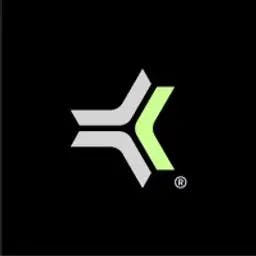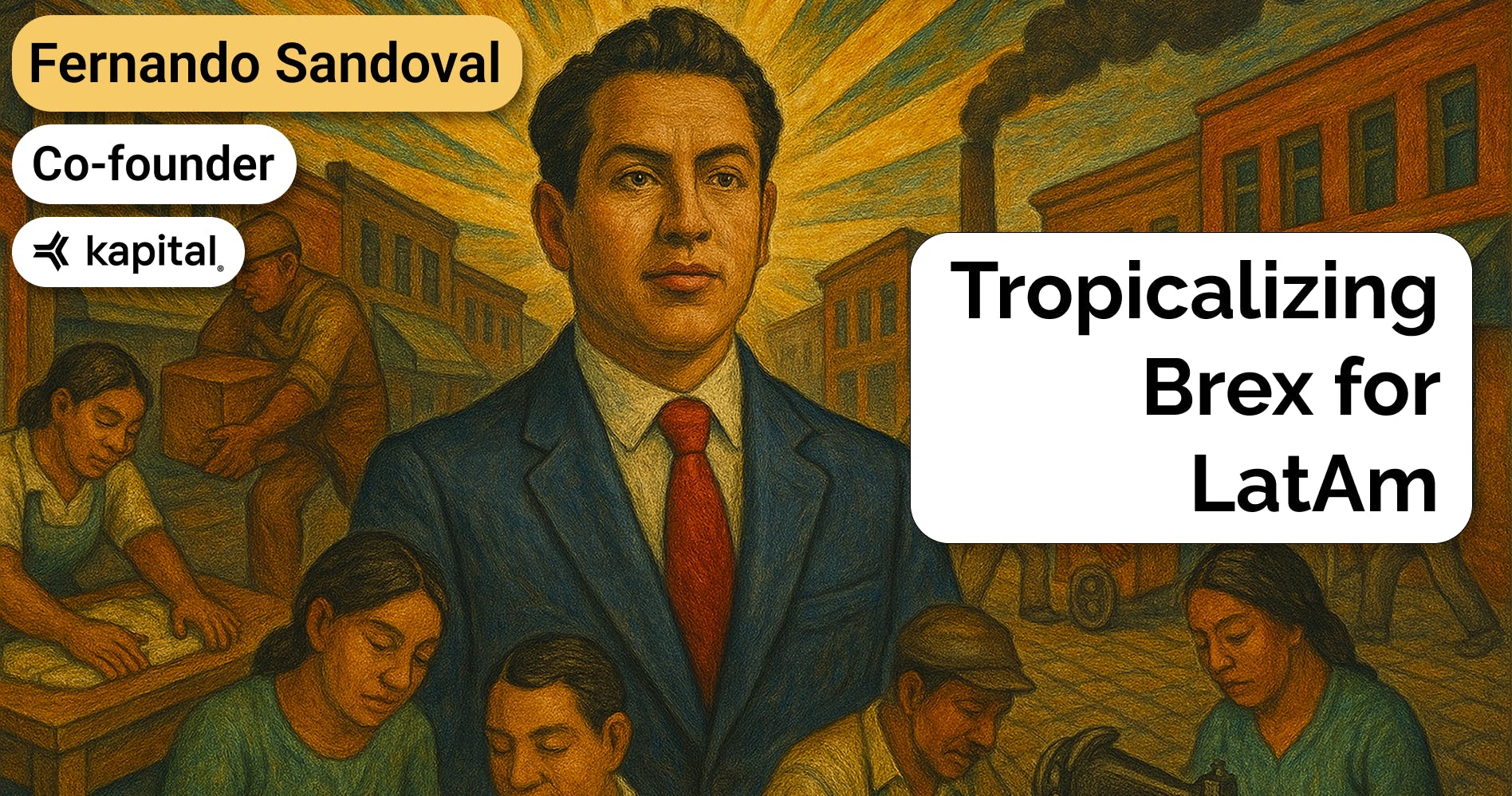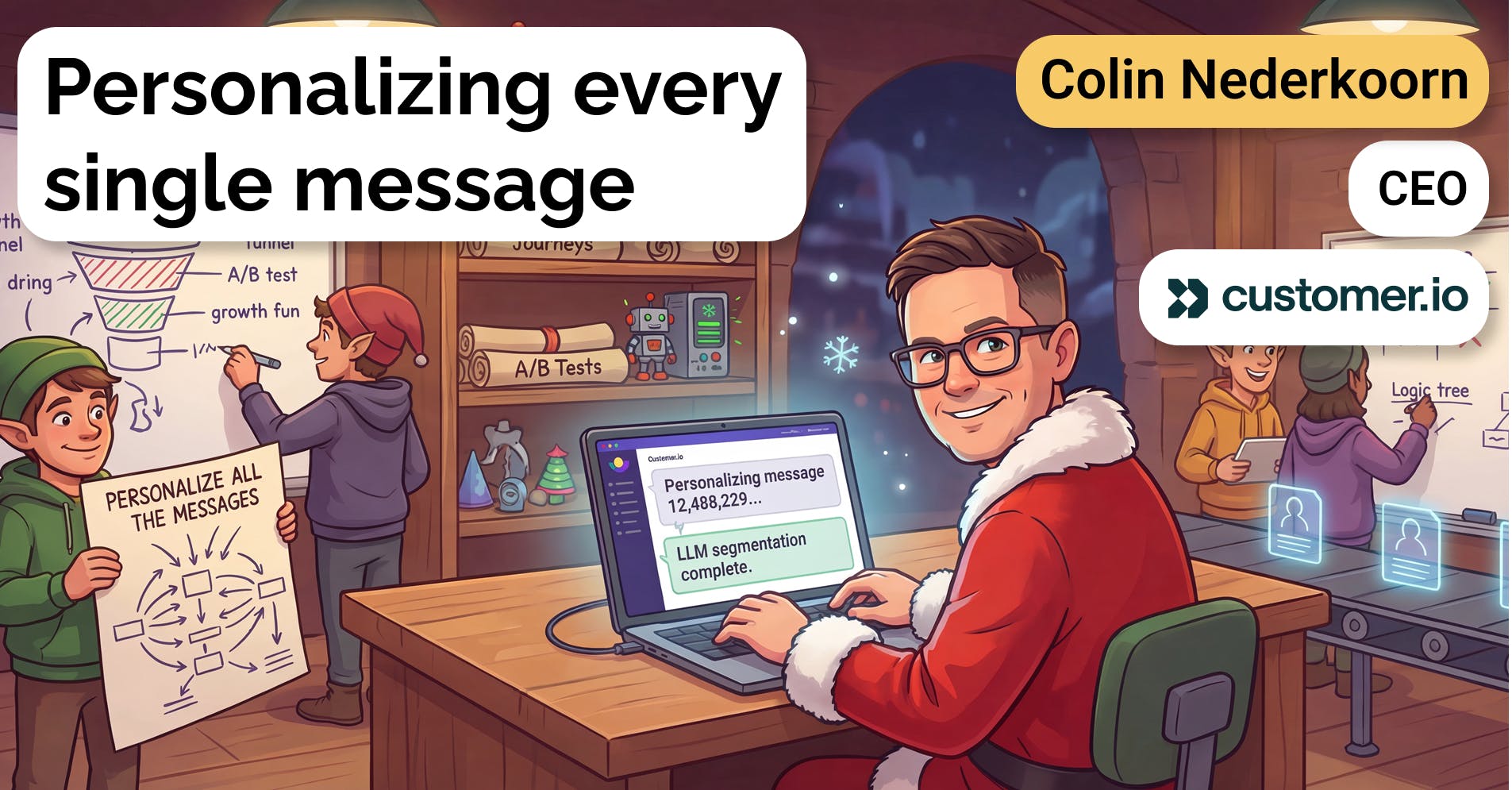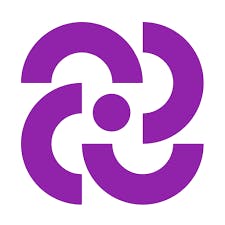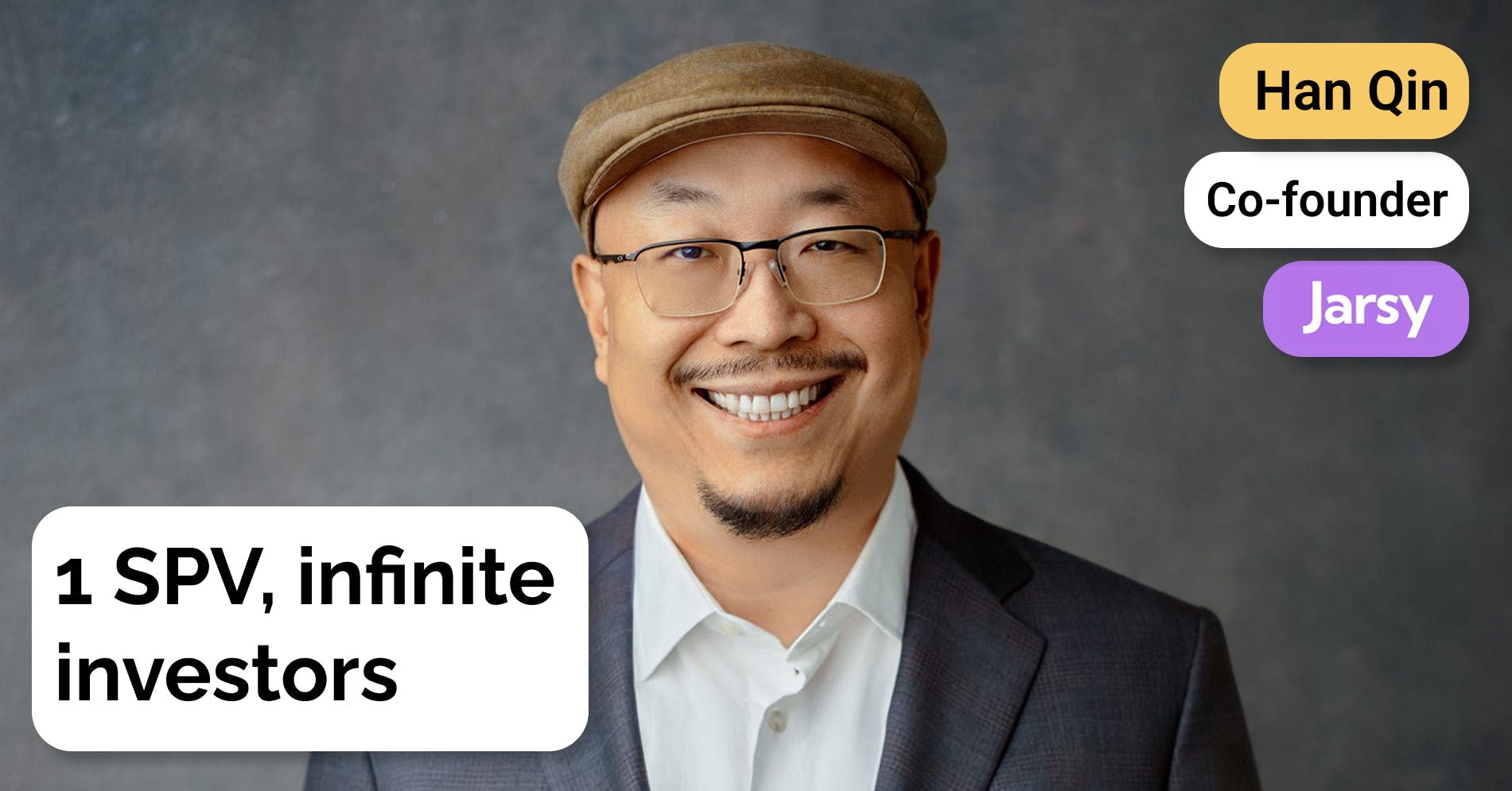René Saul and Fernando Sandoval, co-founders at Kapital, on the fintech opportunity in LatAm
 Jan-Erik Asplund
Jan-Erik Asplund
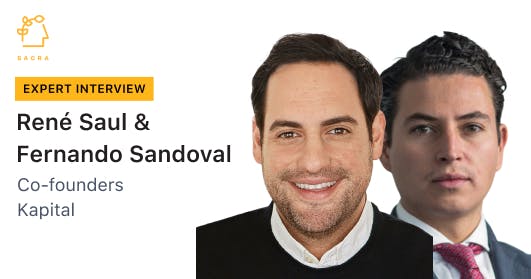
Background
René Saul and Fernando Sandoval are the co-founders of Kapital. We talked to René and Fernando to learn about LatAm's infrastructural and social advantages for B2B fintechs, how Kapital drives high LTV:CAC through cross-sell and channel partnerships, and the power of lending as a wedge vs. cards.
Questions
- What is Kapital and what inspired you guys to start the company?
- This is interesting because it's the flip of what I expected. I was expecting the entry point was more access to capital. But you're saying access to capital is already there, but it's a commodity?
- Mercury started as a bank and now they're layering on additional services. They have a card, they have lightweight expense management, they have venture debt, and you could imagine them also adding in bill pay and some of that stuff. As they layer on more product, does that then resemble what Kapital is, or is it fundamentally different?
- When you say that in the US or in Europe, you have to upload the invoice versus at Kapital, everything's electronic in Latin America, is that because there's existing SaaS and fragmentation in the US and therefore that's the easiest way for these systems to talk to each other versus in Latin America, there's just Kapital? Or is there something else that I'm missing?
- Can you talk about Kapital's customers? Why do they choose Kapital and what alternatives might they be looking at?
- You mentioned ‘the Mexican IKEA,’ is there a point right now where companies graduate off of Kapital maybe because they’re too big?
- Are there any key features that are on the roadmap right now that enterprise customers need?
- In the aftermath of the Silicon Valley Bank implosion, one of the things that was recommended was diversifying your funds across multiple banks. So, instead of just having one bank where all your funds are, you diversify your risk so that you make sure you have FDIC insurance in the amounts across multiple banks.
- One of the most interesting things—and I know Drib and Arjun highlighted this in their piece—is monetizing early and having a subscription SaaS product. In your case, it's the automated intelligence dashboard. Can you talk about how you identified the opportunity to charge upfront for SaaS versus trying to offer as much for free as possible, which is how Mercury and some of these other folks got started?
- Can you explain the different revenue streams that you have and what the revenue split looks like? Or what the order is for those different revenue streams?
- One of the neobank success stories has been Nubank. Is there anything in particular that you've learned from seeing their success when it comes to lending as a consumer neobank in Brazil? Are there any lessons that apply, or are there any lessons or things that you've taken away from their success?
- Can you talk about the countries that you're in now? Are you only in Mexico or have you expanded into other LATAM countries? And then, also, René mentioned Southeast Asia having some similar characteristics. Is that only in terms of e-invoicing? Or is that also a potential area for expansion?
- How do you think about or approach geographic expansion and go-to-market in new markets?
- One of the themes of at least American and European neobanks is rising CAC, especially with increased competition and LTV flat. What structural advantages do you think Kapital has in terms of maintaining and driving down CAC?
- I'm interested in talking more about expense management just because it's a big theme in the US with Brex and Ramp. In LATAM and in Europe, companies like Klar and Clio, there's lower interchange revenue. Can you talk about that dynamic and how that affects how you guys build your product?
- Can you talk about fintechs like Konfio? I don't know if they're directly competitive or how you think about their positioning against not just incumbent banks, but all other fintechs?
- We talked about net dollar retention. Can you talk about how you think about expanding it over time with your customers? What's a common trajectory of adoption of products within Kapital?
- Can you talk about some of the financial infrastructure? I don't know if you use providers in your fintech stack—for example, in the States, Marqeta with cards, Bancorp, Stride, Evolve, Synapse—I don't know if there's any infrastructure providers that have been particularly important or that you work with? Curious to learn anything there.
- What are your thoughts about the opportunity in payroll and global payroll? That would mean competing with companies like Deel, which have become quite large post-COVID, and then locally, LATAM companies like Ontop that do global payroll.
- From the perspective in the States, we've seen how the recent downturn has made it harder to raise capital for startups. A lot of companies have gone under, and also, net dollar retention has dropped. It's been harder to grow. What’s the environment right now in LATAM with respect to these macro-dynamics and how does that make it ripe for Kapital? As you said, it's great timing right now. How does that translate into good timing for Kapital?
- Can you talk about the fraud problem in LATAM? Because we were talking about cards, for example, and how hard it is.
- Anything else we didn’t chat about that you wanted to discuss?
Interview
What is Kapital and what inspired you guys to start the company?
Fernando: Kapital started back in 2020 with three founders. My two partners, which are René, the CEO, and Eder, the Chief of Business Development. They used to operate this offline lending business, and they really became experts in how to lend—and more importantly how to collect—and how to give money to small and medium companies.
René understood that if he wanted to have a business that lasted for more than five years, he needed to invest all his money in tech. He wanted to keep the business—it was a great business, a cash cow that generated a lot of money in Mexico and Peru and other regions—but it didn't make sense. They weren’t fixing anything within SMB (small and medium businesses in Mexico) and were just providing a commodity.
He understood that the main problem with SMBs was that they didn't have enough visibility and control over their own companies. They didn't know what was going on.
There's a huge lack of financial products in Latin America. There are only between twenty to fifty banks per country in some places, compared to in the States, where there’s over 80,000 financial institutions. The market is really different, and it’s dominated by foreign banks like Citi, HSBC, Santander, BBVA, and others that do not invest in tech.
Those big banks will give out loans to big corporations and to consumers, but the small and medium-size companies have been left behind, and nobody is addressing them.
René: SMBs actually represent 50% on average of the GDP. And nobody sees the importance of them and how we need to help them improve their finances so they can continue to perform better.
Fernando: René says “Okay, we need to invest everything in tech, but we need to redesign our banking platform.” As you know, in order to control an entire company's cash flow, it's all about the current accounts, but banks here haven’t invested in new software for more than 30 or 40 years. They’ve changed small details, but not the core of the infrastructure.
So the three of us Kapital founders have known each other since we were little kids. Previously, I worked at this credit rating agency called HR Ratings. I was one of the initial team. Back in the day, it was a startup when there were no startups at all, like 15 years ago. And it was a great story because we became a market leader. We became bigger than Standard & Poor's (S&P) or Fitch and Moody's.
More importantly, I was in charge of analyzing all these financial institutions. I analyzed all the banks, all the fintechs back in the day, and all the financial institutions. One day René called me at the office and he told me about his idea, which is that the main problem companies have is that they don't have control and don't know what’s going on. They don't have on-time information to make fast decisions. If you ask an accountant if the company is winning or losing, they don't know! The answer is “Let me check,” and you're still waiting 15-30 days later.
If you have a business, you need to be able to make decisions right away. Business owners here usually make decisions based on their gut, based on a feeling, etc, but they don't have data. So, I told René that if we can give access right away to a company's information with one click and take control of the whole company's cash flow, I think we have a good value proposition there.
We redesigned the banking platform, and on top of that, we added these financial products, multiple current accounts that operate 24/7. It's like a B2B payment platform, where you can pay vendors and payroll, and you have access to credit cards and working capital loans as well.
René: There’s something important here about why we decided to put all of this ERP functionality in their bank account. The owners of the SMBs or their accountant or their CFO, the only place they look is where their money is. They usually run seven different products for financial feasibility, but with us, we centralize it, and now they only need one. That's our competitive advantage and the thesis that we built Kapital on.
Fernando: If you want to compete just by providing a financial product, you don't want to compete in pricing, you want to compete in value. You have to understand that financial products are all commodities—credit card commodities, current income commodities, and working capital loan commodities. If you give this real-time information to the company, it's a game changer. And that's why we switched the thesis.
We're not like Brex or Nubank who only give businesses a card. Also, if you want to provide a card, what are card expenses? Only 10% of the total expense of the company? That’s not enough information. We give you control of the whole company's cash flow, not just 10%, and that's how we started running the business.
This is interesting because it's the flip of what I expected. I was expecting the entry point was more access to capital. But you're saying access to capital is already there, but it's a commodity?
René: It's the hook. The loan is the hook. The differential thing about our product is that our loan is different.
We give you a revolving line in the banking platform that's bundled with an ERP where you can select the invoices that you need to pay to your vendors and we let you defer them in different installments. Nobody has that technology. We were the first ones to do it.
As far as why, it's like what Fernando was saying at the beginning. We centralized everything, so we know exactly who owes you money and who you owe money to, so you can keep track of it.
Mercury started as a bank and now they're layering on additional services. They have a card, they have lightweight expense management, they have venture debt, and you could imagine them also adding in bill pay and some of that stuff. As they layer on more product, does that then resemble what Kapital is, or is it fundamentally different?
René: We have several functionalities that are alike. That's just because of the nature of our business, but we're completely different. Why?
Because we're a bank. That's the first thing.
Secondly, we are an ERP that gives you visibility, and Mercury doesn’t do that. You don't need to connect to other ERPs in our banking platform. We give you that information that you don't have.
For example, we have the payments model. On the payments model, you can just select the invoice and we do everything for you. There's the amount, you can just select it and you can send the money to your vendor.
On the other side, for example, in your collections, you see who owes you money, and with a link, you can collect the money from your client. We simplified the treasury for you, because usually, for all these, you’d need several different financial vendors.
For all those transactions, you’d need around six separate systems—the financial system, the inventory system, the CRA system, the planning and budgeting system, and the e-commerce system. You’d usually need a lot of systems to run your whole company. But with Kapital, you can reduce it just to two because everything is concentrated there.
I know that Mercury is going that way, but they don't have the technology we do, because in the US, the account is different.
Here’s how we simplify this: In Latin America, all the invoicing is electronic, so, we just connect everything for you. And once you log into your platform, we get you the information.
What happens when the invoicing is manual in the US or in Europe? You need to upload the information to your ERP. And then, what do Mercury or Brex or these types of companies do? They connect to the ERP and they put it in your bank account. With us, you don't have to do that, we give you the information. We already have it. We built it that way, and that's our competitive advantage.
Plus, we have banking because you need the bank account to send wire transfers, to pay vendors, or to collect money. We hook you with the loan, because as Fernando was saying, it’s difficult for SMB to access credit here. That's how we centralize.
Fernando: Latin America is not as sophisticated or as advanced as the United States, Europe, the Nordics or Japan. Here, there's a huge need for financial services.
In the States, the margins from lending are small. In Europe, they used to be negative like five years ago. In Japan, they’re negative, there's no financial business.
But in Latin America, you can cap margins from 50% to 70% if you give a loan, depending on the business needs you are addressing. And Latin Americans are not used to hiring SaaS. In the States, everything is SaaS. When you start a business, you already have five SaaS to organize. Latinos are driven in business, but the back office is always a mess.
What we did is address a short-term need by giving them the loan or the credit card as a hook and we plugged into their SaaS. And so, they start operating their SaaS with us, their current accounts, they have real-time information, all the invoices, accounts receivable, accounts payable, and they can pay their vendors, etc. And that's when the transaction starts increasing and increasing, and also, the net dollar retention starts increasing.
What we’ve noticed is that we control the most important side of the company. Why? Because it's where they keep their money.
Like René said, this is the only screen that business owners look at all day long: how much money they have, how much money they need to collect, and how much money they need to pay. That's all they need to run the business, these principles, these three things, as simple as that.
When you say that in the US or in Europe, you have to upload the invoice versus at Kapital, everything's electronic in Latin America, is that because there's existing SaaS and fragmentation in the US and therefore that's the easiest way for these systems to talk to each other versus in Latin America, there's just Kapital? Or is there something else that I'm missing?
Fernando: For invoicing, if you have a formal incorporated entity and you want to make a sale, you need to issue an invoice. But it's not a PDF. You need to tell the government that you're issuing an invoice, and it's a digital electronic invoice. There are more than 80 countries in the world that manage the IRS using this e-invoicing feature.
Can you talk about Kapital's customers? Why do they choose Kapital and what alternatives might they be looking at?
Fernando: When we started, we were focusing more on SMBs, and what we noticed is that the stronger the tech, the stronger the customer. We started addressing companies that have from 10 to 100 employees with an ARR from $2 to $10 million. But right now, to give you an idea, our biggest customer has more than 8,000 employees.
The other day, they called us and said “Guys, I'm tired of using my bank. I just centralized everything with you because you give me full visibility of where I'm standing.”
This company is like the Mexican IKEA, and they have more than 30 to 40 branches. With our banking platform, they know how much money they owe between third parties and they have full control. Before that, they were lost and it was a mess. So those small details are the ones that count.
René: Exactly. If you're running six separate systems, it's going to get complicated. Like Fernando just said, that's why the IKEA of Mexico centralized those six different systems with us. That's our competitive advantage and that's how we generate loyalty. That's why we have a strong net revenue retention and low churn.
We’re built on this idea of simplifying and centralizing finances in one place, and the only way you do it is by combining the bank, the ERP, and the loan products all into one place. We’re like a lot of fintechs combined into one. And the reason we’re able to do it is because the technology is there. If we wanted to do this 10 years ago, we just couldn't. So, right now, the timing for us is perfect, and that's our approach and that's how we're going to keep building Kapital on.
Fernando: When we were in YC, our tagline was “the first data-driven bank.” That was back in the day before data became this trendy world.
When we started, the first team we hired was a data team, because everything is about the data you can collect to help the business. It's not about having the data, it's about what you can provide to the customers. And that's why we're adding all these AI features—we want to become your financial advisor, your financial manager, etc—so the company can focus on where to add value, that is, through producing and selling.
You mentioned ‘the Mexican IKEA,’ is there a point right now where companies graduate off of Kapital maybe because they’re too big?
We don't want them to. Because there are other startups that say ‘I only want SMBs. And once they become bigger, I don't mind, they can go to these SAP solutions, for example.’ No, we made this to scale across the customers, and that's why we're going to keep releasing features to help bigger and bigger customers need us and add value to them.
Are there any key features that are on the roadmap right now that enterprise customers need?
Yes: consultation and automatic consultation processes. Everything about banking is offline and it's manual. We're going to release a lot of automatic products that help our customers operate right away. I receive a lot of offerings by phone, like, “Hey, do you want this product?” “Yes.”
In the States, if you want to make an investment, I need a physical phone confirmation. My investor needs to call me from the States. Is this for real? Why is there not an app where I can authenticate myself in the app and just operate it from there? Again, the small detail is what makes the difference, and that's how you separate from having a commodity into a real value proposition.
In the aftermath of the Silicon Valley Bank implosion, one of the things that was recommended was diversifying your funds across multiple banks. So, instead of just having one bank where all your funds are, you diversify your risk so that you make sure you have FDIC insurance in the amounts across multiple banks.
René: That's usually the traditional way of thinking. But right now, you need to have one account to run all the operations, and you also get some investments as a bank being there. That's how we profit from the deposits.
Right now, the Mexican financial system is very strong. Why? Because of the nearshoring. A lot of money and a lot of tech companies, like Tesla, are coming to Mexico. Mexico is one of the biggest winners of globalization and a country that has particularly benefited from globalization issues. That's why we need to keep the strength in the financial sector with our solutions and keep controlling the customers like Kapital does.
Of course, some customers are going to be diversified. Yes, that's just the logic of things. You need to be diversified. But the bank account that has the most deposits is usually going to be your operating account. And that's what we are, and that's why people pay us a SaaS. We get them the loan, and that's how you own them.
One of the most interesting things—and I know Drib and Arjun highlighted this in their piece—is monetizing early and having a subscription SaaS product. In your case, it's the automated intelligence dashboard. Can you talk about how you identified the opportunity to charge upfront for SaaS versus trying to offer as much for free as possible, which is how Mercury and some of these other folks got started?
Fernando: I don't know what happened two or three years ago that all the startups that came along gave away everything for free. They’d just put out the freemium model and see what happened next. But the thing about this is, if you start a business—again, this is not an NGO, and I don't have anything against NGOs and they're really important—but this is a business, and you're raising money to pay that money back. You need to find ways to charge money and generate revenue.
How do you know that you have a product market fit if you don't charge for your product? You don't. And if your customer is willing to pay for your products, that's the proof you need to see if you have a good MVP and a great product.
When we started, we liked to collect from all different revenue streams, and customers wanted to pay for that. They weren’t sensitive to that because they liked the solution. The thing is, usually SMBs don't pay for tech. Everything is either on Excel or in their heads. Since we’re the only providers of this kind of on-time data, they started noticing that it’s really valuable. Once they operated on the platform, and we gave them control back, they liked it. All day long the business owner is out on the street collecting, then they open the app and can see how much money they owe and they can send payment links right away. And that's why we're capable of charging for our service because we're providing real value to the customers.
Can you explain the different revenue streams that you have and what the revenue split looks like? Or what the order is for those different revenue streams?
Fernando: Yes. To give you an idea, 60% of our business comes from interest income from the credit card and the capital flex or other long-term loans, and 40% comes from tech revenue.
What is that tech revenue? That tech revenue comes from the SaaS that we charge for, that’s the hook. That's how we anchor the customers and that's how we created a really sticky product.
We also have wires, so we charge for the wires and ACH. We have interchange fees. We have funding fees for the prepaid cards, all these payroll payments, etc.
The thing is, the customer is not sensitive to whether you're charging for a wire or not. I know in the States, it’s pretty pricey, but in Mexico, it was a quarter of a dollar, to give you an idea. It’s not expensive like it is in the States, so they don't mind paying. And that's how you generate money as well. By having these different revenue streams, you build a strong business.
In order to have a resilient business, you need to have multiple revenue streams because if something happens to any type of industry, you can still generate revenue. If I have issues with credit, it doesn't matter. I generate wires, I generate SaaS, I generate payment fees, etc.
If the economy moves, the company is still going to move along and generate enough cash flow to survive. That's how you need to think because if you're a startup, you're always in a survival mode, always assuming the worst and more. I used to say to my investors, “Man, we're Latinos.” I was born in crisis, raised in crisis, graduated in crisis, and started my business in crisis. So, this is our mindset. We're always thinking about the worst and preparing for that.
One of the neobank success stories has been Nubank. Is there anything in particular that you've learned from seeing their success when it comes to lending as a consumer neobank in Brazil? Are there any lessons that apply, or are there any lessons or things that you've taken away from their success?
Fernando: There's so much to do in Latin America. And for us, Latin America is the right region to be in because we’re in the right stage of innovation—we’re in the right stage of progress. The businesses and the consumers are open to tech options. Of course, everything started with Mercado Libre back in Argentina, and after that, it was Rappi in Colombia, then Nubank in Brazil. In Mexico, you have other players that are important as well. But it's about how companies and the region start developing, and it's about how all the economies start digitizing. All these cases are examples of how tech can provide simple solutions in an efficient way and by adding value to the customers.
We want to become the neobank for B2B. That's the core and that's the idea. What we like about B2B is that B2B is way, way stronger than B2C and less riskier in the financial industry, because you're giving loans to produce. It's a working capital loan. You're not giving a credit card to a consumer to pay for a quinceanera party. The angle is different and the risk is different.
Of course, the fintech industry has developed a lot in Brazil and in Mexico. But there's so much to do right now, and it’s not going to be one winner takes it all. Again, you have around 80,000 financial institutions in the States, and we only have 50. And 5% of those 50 controls 99% of the assets.
In Brazil, for example, the finance over GDP is around 65. In Mexico, it's 35. Imagine how many banks can be there to go up to 65. It's massive. And we're the second biggest economy. This is the same for Colombia, for Peru, for Chile, etc.
Can you talk about the countries that you're in now? Are you only in Mexico or have you expanded into other LATAM countries? And then, also, René mentioned Southeast Asia having some similar characteristics. Is that only in terms of e-invoicing? Or is that also a potential area for expansion?
Fernando: We started in Mexico. And after that, in September 2022, we went to Colombia. Right now, we're also expanding to Peru. We already have the plug and play solution to expand all across LATAM, and once we’re across LATAM, we want to expand to other different regions because the SMB problem is global. The legacy players don't have the digital channels to address them efficiently and it's a mess. SMB owners need to go to their physical branch and lose the whole day, and sometimes they still don’t get an answer. It's a lot of bureaucracy.
When we went to Colombia, it was great. Usually, when you talk about LATAM, it's Brazil and Mexico. That's it. But LATAM is way bigger than that. There are all these different countries that can give you access to other types of markets to keep scaling. In Colombia our brand is already positioned there.
How do you think about or approach geographic expansion and go-to-market in new markets?
Fernando S.: We always say we want to expand where our solution is needed, where we feel like the problem is the biggest. That's why we went to Colombia, then Peru. After that, we like Chile, and we like Argentina.
Now, with the new elected government in Argentina, let's see what happens—but it’s moving in a positive direction.
Brazil is also really interesting. But Brazil is for the Brazilians. It’s similar to when Brazilians want to come to Mexico, they say “Mexico is for the Mexicans.” You need to do it really smart. If you go to a bigger market, I think the best way to do it is by acquiring a company instead of starting from scratch. It depends on the strategy in each country.
One of the themes of at least American and European neobanks is rising CAC, especially with increased competition and LTV flat. What structural advantages do you think Kapital has in terms of maintaining and driving down CAC?
Fernando: When you start scaling your business, one of the biggest mistakes you can make is putting a lot of money in digital marketing. Digital marketing is not that efficient overall, and it’s way less so in developing countries.
I'm the CFO, so I'm really cheap. I hate giving money to social media. When we started, for almost two years, we needed to find ways to acquire customers in an efficient way and keep surviving, because we needed to pay the payroll, etc.
The most efficient way to scale a B2B business is by having a referral strategy and partnerships. These two things are anchors to control the CAC.
Instead of burning $100,000 or $1 million in digital ads—and you don't know how many are going to convert—I prefer to pay that money to my partners. I'm going to pay them only if I convert a customer. And that's how you control the CAC and how you can scale efficiently in the midterm up to the long term.
We have a partnership with the biggest SMB chamber of Mexico, and another in Colombia. That's how we get the addresses, we get the databases, email marketing, and a call center, etc, physical events, like physical summits. And that's how we start creating awareness and letting companies know what we offer.
I'm interested in talking more about expense management just because it's a big theme in the US with Brex and Ramp. In LATAM and in Europe, companies like Klar and Clio, there's lower interchange revenue. Can you talk about that dynamic and how that affects how you guys build your product?
Fernando: It’s way lower. Again, each region has its differences. It's way easier to be like, with all respect, a copycat.
If I find a good business model in the States, I can take it back to Mexico, or move it to Europe or move it to Southeast Asia. But you have intrinsic variables that may change the business a lot. Interchange fees are way, way, way, way lower. And interest rates from central banks in Latin America are way, way, way bigger. If you want to fund 30 days from a service card or a credit card, etc, whatever, your revenues interchange and the effective interchange is, in the States, it's like 1.7% on average. And if you analyze that, it makes sense because you have a 5% rate.
But in Mexico and Colombia and Brazil, you have central bank rates that are around 12%, more or less, between each country. If you analyze that interchange fee, it's not a business at all because the money has a cost. Also, the interchange fee is not 1.7%—it goes down to 0.8%, 0.9% for credit. For debit, it’s around 0.4-0.5%.
For us, how we see the card is as an add-on to create a hook and to create stickiness. We're pretty efficient. Yes, we generate revenues from cards, but you need to really know how to operate the business. You need to be an expert, because in the financial industry, it's one of the most difficult business units, the cards. It's a mess.
Expenses are a huge product in the States. But again, they usually start with the card. You only know the expenses you have on the card. You don't have full visibility of how much money you're spending in invoices, how much money you're collecting, et. And that's one of our main value propositions.
Yes, we can give you the expenses of the card, but we also give you 90% of your other expenses, and that's how we can provide data of what’s going on with the company across all your expenses. That's how we can give you advice, we can dictate it right away if you have recurring vendors, non-recurring vendors. If you want to pay, we can pay for you right away every 30 days if you want.
If there's a recurring vendor that an invoice went way higher, we stop the payment and we'll let you know, “Hey, you need to verify your telecom invoice. You used to pay $30, it went up to $1,000. Call your vendor.”
The main issue when it comes to a credit card, for us, is instead of gaining control of the company, you lose control. It's way easier to put all the vendors in the credit card, but then they charge you every month. Sometimes you lose track and you forget to check the charges and validate them. We work the other way around—you have the control over the company. You decide when to pay and when not to pay.
Can you talk about fintechs like Konfio? I don't know if they're directly competitive or how you think about their positioning against not just incumbent banks, but all other fintechs?
Fernando S.: How we position is by competing in value and not in price. Konfio is focused on digital lending. Klar is focused on credit cards. There's another fintech that’s focused only on current accounts.
Again, you can go to a legacy bank that you trust more because they're a bank and they’re regulated, which is why we flip the thesis and we compete on the basis of our cash flow and treasury management tool.
We designed our ERP so that when you access your bank account, you'll see how the sales are going and you can filter it down by month, by week, by the last year, etc. How are the expenses going if the business is winning or losing? You know right away the accounts receivable and the accounts payable. And we put all these financial products in one place, current accounts, the credit cards, and the working capital loans. That's how we compete—giving a platform that actually helps you operate the business.
We talked about net dollar retention. Can you talk about how you think about expanding it over time with your customers? What's a common trajectory of adoption of products within Kapital?
Fernando: That's a great question. I think digitizing and automating the financial department is really important for us—releasing different features like financial products that customers also need to keep enhancing the ecosystem we're building. Payroll calculation, invoice generation, international payments, we have all that stuff. We're just perfecting all these products, because the stronger the offering, the more you can convert customers to using the platform right away instead of having different players. That's how you hook the customer, and that's how they started transactioning more and more.
The most important part is the AI feature. It has a search engine where you can search who’s the cheapest vendor for this stuff, and we can find you a cheaper vendor right away. And it can also work the other way around. How much can I sell this product for? We can cross the supply and demand right away with all the information we have. Also, you can search how much money you’ve spent with a vendor in the last year right away. Boom. It can give you a report right away.
If you had a traditional accounting ERP, it's a mess. Call your accountant, tell him to make the report, it takes one week at least. How I like to compete is giving on-time features, on-time services, on-time visibility right away. Banks work from Monday to Friday. We work 24/7. You want to make a payment on Sunday because you need to pay a payroll because you're a construction company, you can do it.
Can you talk about some of the financial infrastructure? I don't know if you use providers in your fintech stack—for example, in the States, Marqeta with cards, Bancorp, Stride, Evolve, Synapse—I don't know if there's any infrastructure providers that have been particularly important or that you work with? Curious to learn anything there.
Fernando: There are different players in LATAM. Marqeta is not here in LATAM, but there are different players depending on the country that gives you the banking as a service. They can give you the BINs for the cards, etc. You have the legacy players, Prosci Global in Mexico. In Colombia, you have the banks that control that. Each country has its own rules and you need to really understand them. You also have new players like Dock, a Brazilian entity.
In Mexico, we started with different vendors. But right now, we are a bank in Mexico. We acquired a bank license, so instead of having a vendor to have a wire, we can connect directly to a central bank. By having a stronger permit, we can leverage an actual infrastructure, not just in Mexico, but all across LATAM.
It's not the same by going out to Chile. I'm a Mexican startup, but I want to do business here, that I'm a Mexican bank. It's way, way different. And also banks are the most regulated entities in the world. But if you're a fintech, sooner or later, you're going to become a regulated entity, so you need to understand the rules of the game and take advantage of that.
What are your thoughts about the opportunity in payroll and global payroll? That would mean competing with companies like Deel, which have become quite large post-COVID, and then locally, LATAM companies like Ontop that do global payroll.
Fernando: We're not in that industry right now. We do a payroll calculation on payment, but not global payment. But we're working on something interesting that we’re going to let you know about soon. That’s for the next story.
From the perspective in the States, we've seen how the recent downturn has made it harder to raise capital for startups. A lot of companies have gone under, and also, net dollar retention has dropped. It's been harder to grow. What’s the environment right now in LATAM with respect to these macro-dynamics and how does that make it ripe for Kapital? As you said, it's great timing right now. How does that translate into good timing for Kapital?
Fernando: If the States is having a busy winter, Latin America is way worse because that’s what happens. People are putting money in the most safe areas instead of developing regions. But if you look at the last 50 years, Latin America is way, way different.
50 years ago we had a lot of political instability. Today, LATAM is where you want to invest because that's where the opportunity is. There's so much to build here. Europe has everything built up already. In Latin America, you just need to have some logic, a business idea, and execute it.
It does not need to be tech. It could be tech or non-tech. If you know how to operate a cash flow, that's it. And that's the story of a lot of entrepreneurs. It's really common. Most of my friends and my partner's friends, they're entrepreneurs, by nature. Because you're not depending on the government, you're depending on yourself to make a life. You generate by yourself and save for your life and your pension etc, or you're dead.
Again, the biggest fortunes are built in LATAM, there are the biggest families. There are a lot of ways to disrupt that fortune because they don’t invest in tech. All these legacy banks, the richest branches are in Mexico. Santander, HSBC, Citi, BBVA, Scotia, for all of them, Mexico is the crown jewel. The Mexican branch is the one that saved them from the 2008 crisis. And my point here is to see the opportunity, how much we can do all across, and Mexico is one example. Brazil is pretty similar. Chile, Peru, etc.
Can you talk about the fraud problem in LATAM? Because we were talking about cards, for example, and how hard it is.
Fernando: We Latinos are pretty creative. It's definitely a thing. Mexico and Brazil are the two biggest markets—we have more fraud globally. So, we need to use that creativity to put a business together instead of making fraud. The thing is, you need to always plan for the worst, that’s what I told you back a few questions ago.
We needed to think of ways that they could make a charge without having a card. So everything's about security—digital tokens and blockchain security in order to protect our customers.
The good thing is legacy players are way behind on that, and that's another competitive advantage for us, because we can provide stronger security measures than other players. That’s really important.
I've been in talks with these card branches to ask, ‘What has been going on? What are the trends? What have you faced?” You also need to separate conflicts of interest within the company. Small detail. The sales team cannot be together with the credit team. As simple as that. If you separate these small details in the company, that's how you build a strong company and prevent fraud, and to prevent the external mob from getting inside the company.
Anything else we didn’t chat about that you wanted to discuss?
This business is not about lending, it's about collecting. You need to know how you’re going to collect. Again, there could be really a lot of reactivity, but you really need to understand what the real cash flow of the company is to give them a credit card, to give them a working capital loan, or to give them any service.
Right now the VCs only like SaaS businesses because it's recurring revenue, but there are a lot of SaaS businesses that don't collect. Instead, we go the other way around, we have a SaaS, we have a loan, etc, and we have stronger legal features to collect because we have a loan.
That’s why you should collect a loan that allows SaaS—legally speaking—because then you have other types of instruments that abide you and help you reduce this fraud. Everything is about the KYB, how you keep digitizing all this KYB to run the process smoothly. I think that's it.
Our revenue retention is at least around 450% and we keep expanding. The more features we release, it's going to expand more. To give you an idea, when the customer started, they made like five payments on the platform.
Right now, they're doing like 60 payments. And they connect every day, they check the balance every day, they extract, etc. And that's how you increase the stickiness and the dollars you make for each customer.
Disclaimers
This transcript is for information purposes only and does not constitute advice of any type or trade recommendation and should not form the basis of any investment decision. Sacra accepts no liability for the transcript or for any errors, omissions or inaccuracies in respect of it. The views of the experts expressed in the transcript are those of the experts and they are not endorsed by, nor do they represent the opinion of Sacra. Sacra reserves all copyright, intellectual property rights in the transcript. Any modification, copying, displaying, distributing, transmitting, publishing, licensing, creating derivative works from, or selling any transcript is strictly prohibited.
